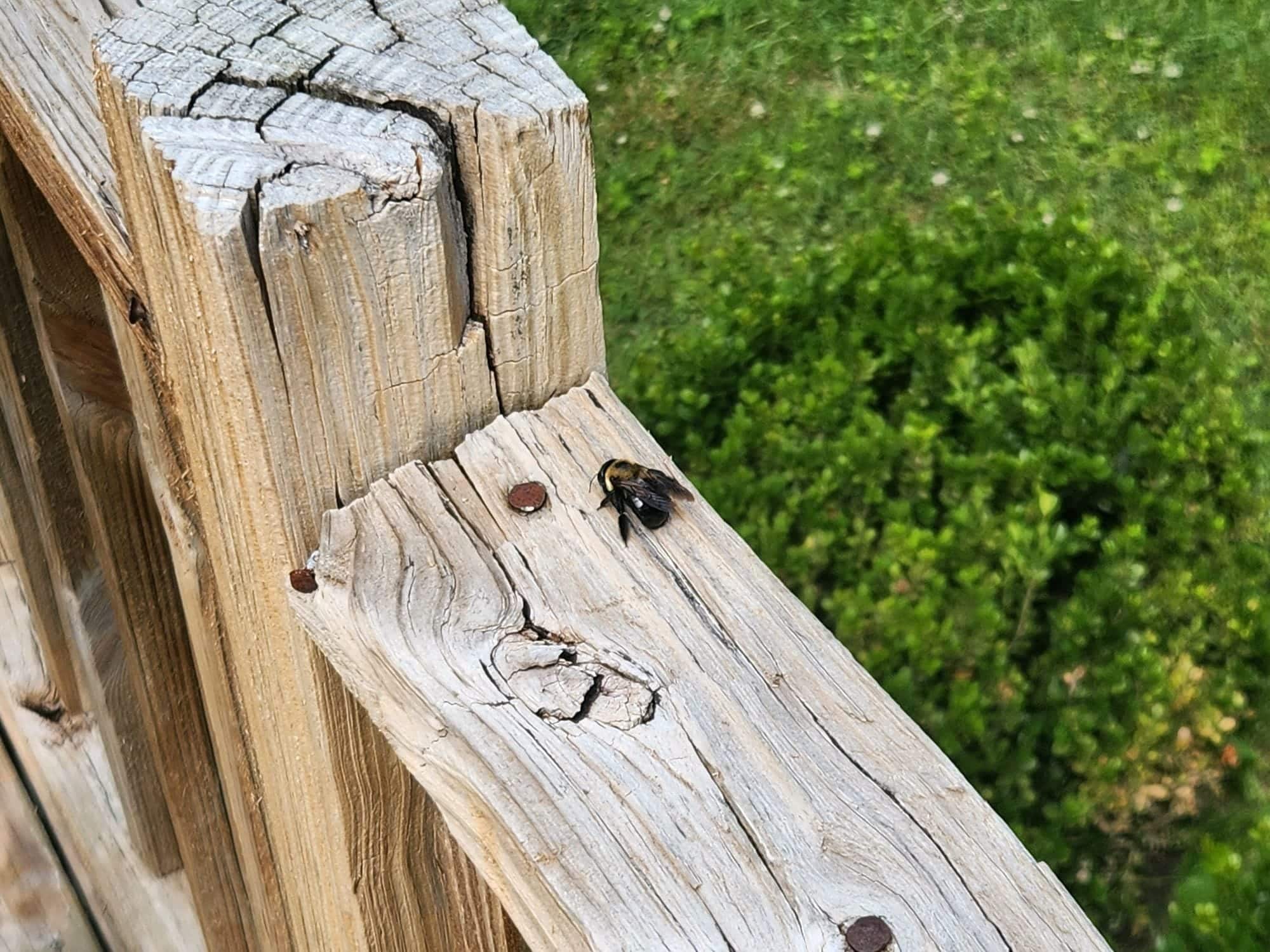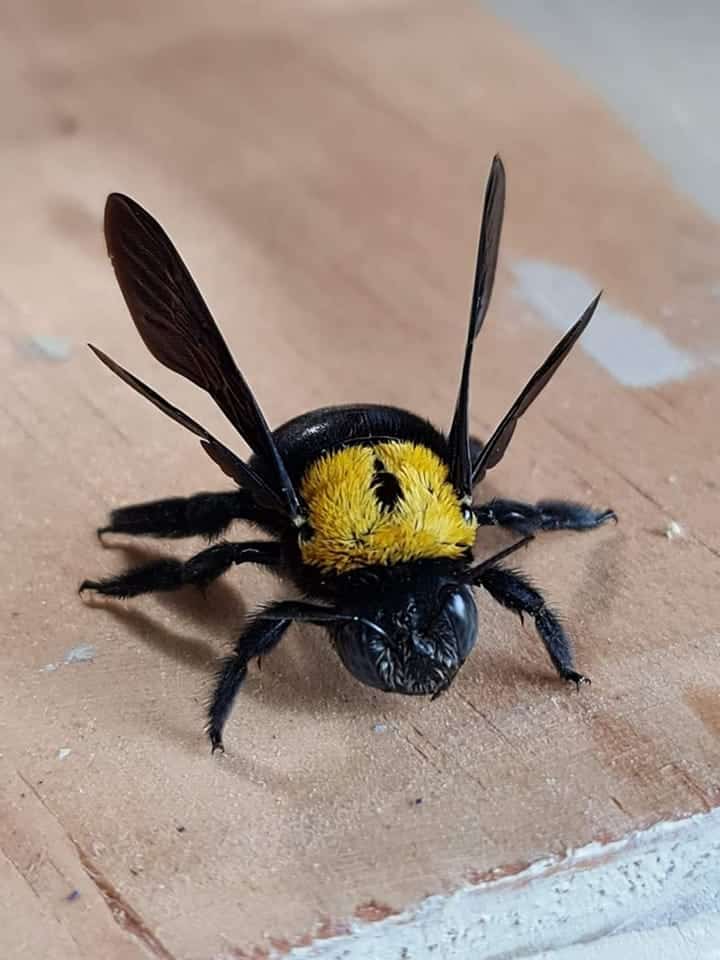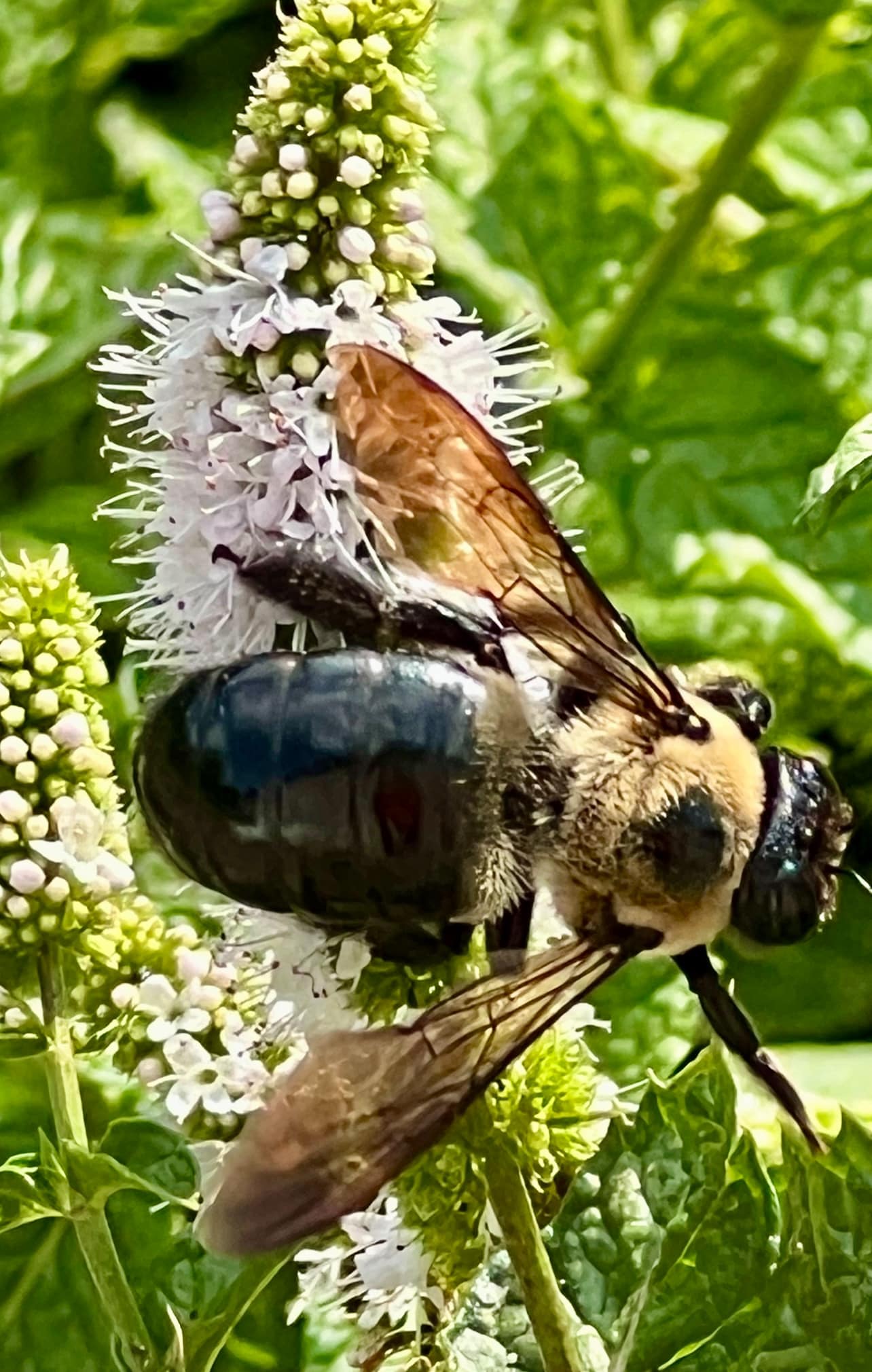Spring is here. After the cold, gloomy winters, nature finally comes to life with vibrant colors featuring flowers, tree buds, and creatures like carpenter bees roam freely. This is truly an exciting time; unfortunately, it has its challenges.
In the case of carpenter bees, while they are beneficial for pollination, these industrious insects are a nuisance should they reside around your home. They bore into wood to create nests, causing damage to structures and potentially compromising your safety.
Therefore, making sure they stay away from your home is essential. Fortunately, this is doable with a proactive approach and simple, effective techniques.
Carpenter Bee Infestation Signs
These common signs indicate the presence of carpenter bees.
a) Round Holes
Carpenter bees create immaculately round entry holes with diameters of approximately ½ inch on wooden surfaces. You will likely find these holes in unpainted or untreated wood.
b) Sawdust Piles
After drilling into wood, carpenter bees push sawdust or wood shavings out of their tunnels. Therefore, small piles of sawdust near the entry holes indicate recent carpenter bee activity.
c) Visible Activity
You may observe carpenter bees flying around your property, particularly near wooden structures. You are more likely to see male carpenter bees because they patrol the area looking for mates while females are busy excavating nests.
d) Boring Sounds
If you carefully listen to sounds originating from wooden structures, especially during the daytime, you might hear the buzzing sound of carpenter bees excavating their tunnels inside the wood.
e) Wood Damage
Over time, the carpenter bee tunnels can cause structural damage to the wooden elements of your property. This damage can weaken the wood and lead to aesthetic concerns or even safety hazards.
f) Presence of Larvae
You may find carpenter bee larvae inside tunnels. They resemble small white grubs and feed on pollen and nectar within the tunnels.
Read More:
How to Keep Carpenter Bees Away
1. Paint Wood
The first rule of successfully stopping carpenter bees is never to leave any wooden surfaces bare. These insects gravitate towards untreated, unpainted, or weathered wood for nest construction. Softwoods like cypress, pine, cedar, and redwood are especially attractive to them.
Therefore, create a physical barrier to make it hard for carpenter bees to burrow into the wood by coating your wooden structures with paint. The smooth surface of the paint will discourage bees from landing and drilling holes, reducing the likelihood of nesting.
Besides forming a protective barrier, paint also helps seal wood against moisture, which can weaken the wood’s integrity and make it more attractive to carpenter bees.
2. Use Hardwood
Carpenter bees find it challenging to bore through hardwoods such as oak, maple, and hickory due to their density and hard compaction. In addition, compounds like tannins and resins found in hardwoods act as natural repellents against insects, including carpenter bees, reducing the likelihood of infestation.
Moreover, hardwood structures are more durable and less susceptible to damage from weathering, moisture, and insect activity, thus providing long-term protection against carpenter bees.
Due to these attributes, construct exterior surfaces prone to attack by carpenter bees with hardwood. These include eaves, fascia boards, decks, and fences.
3. Seal Gaps and Holes
Carpenter bees can build their nests from scratch, but being opportunistic creatures, these insects will seek out pre-existing holes and gaps in the wood. Eliminate potential nesting sites and discourage bee activity on your property by sealing these openings.
Thoroughly inspect the wooden structures in your home for holes and gaps, then seal them with a generous amount of high-quality caulk or wood filler. Also, replace or repair any weathered, damaged, or rotting wood.
4. Install Speakers or Chimes
Certain sound frequencies and patterns repel insects. High-frequency sounds, in particular, disrupt bee communication and navigation, making an area less attractive for nesting.
For this reason, let sound help you keep these insects away. However, ensure the sound patterns or frequencies you choose deter bees while presenting minimal disturbance to humans and other wildlife.
Place outdoor speakers or wind chimes in strategic locations around your property where carpenter bee activity is prevalent. Pick positions with good sound projection and coverage to create a comprehensive deterrent zone.
The constant rattling and movement of wind chimes are especially distracting to carpenter bees, making your home unconducive for them.
5. Hang Fake Wasp Nests
Carpenter bees avoid areas with wasps. Take advantage of this by mimicking the presence of these stinging insects by hanging fake wasp nests strategically around your home. Ensure the nests are visible and accessible to maximize their deterrent effect.
Choose fake wasp nests that closely resemble an authentic wasp nest. Excellent options include those made from natural materials such as paper or cardboard, with a distinctive honeycomb pattern and coloration similar to real wasp nests.
To ensure your fake wasp nests continue to deter carpenter bees, inspect them regularly and promptly replace any damaged or weathered nests.
6. Apply Citrus, Almond, or Peppermint Oil
Carpenter bees are not fond of the smell of citrus oil, peppermint oil, or almond oil. These oils are great carpenter bee repellent since they emit strong aromas and tastes that these insects find unpleasant. Spray these oils into freshly drilled holes to prevent the carpenter bees from continuing their drilling.
In addition, wipe these oils on high-impact areas such as eaves, decks, fences, and siding. When it comes to preparing these oils, simply mix a couple of drops of almond, citrus, or peppermint oil with water in a spray bottle and shake well to combine.
If you want a more concentrated oil, apply undiluted almond, citrus, or peppermint oil directly to wooden surfaces using a brush or cloth. Moreover, experiment with mixing different essential oils with complementary properties to create a concoction with higher overall effectiveness and a multi-sensory deterrent for carpenter bees.
7. Remove Attractants
Before removing attractants, what attracts carpenter bees to an area in the first place? These insects are attracted to untreated, unpainted, or weathered wood, with wooden structures such as eaves, decks, fences, and siding being prime targets for bee activity. Carpenter bees are also drawn to flowering plants and trees as they provide pollen and nectar.
Moreover, carpenter bees will come to your home if there are existing nesting sites or favorable conditions for nesting. These include holes, gaps, or cracks in wooden structures.
Once you identify what makes your property a prime location for carpenter bees, do these to make it less favorable.
- Replace any weathered, damaged, or untreated wood with new, treated lumber.
- Cover every exposed wooden surface with protective coatings like varnish and paint.
- Remove or relocate flowering plants and trees that may attract carpenter bees to your property. You can replace them with less attractive plant species or varieties that are less likely to attract carpenter bees.
- Carry out regular inspections to uncover and fix any potential attractants for carpenter bees. After that, promptly remove or mitigate any conditions that may draw bees to your property.
8. Give Carpenter Bees A Home
Wood drilling around your property by carpenter bees to construct nests can be destructive and a nuisance. Fortunately, there is a way around this problem- providing alternative nesting solutions to these beneficial insects. This way, they can still help facilitate pollination and have a home without damaging your structures.
Buy or build carpenter bee houses to place around your home. If you decide to build, use untreated, unpainted wood to construct carpenter bee houses with dimensions similar to those of natural nesting sites. Drill holes approximately 6-8 inches deep and 1/2 inch in diameter, spaced a few inches apart to accommodate multiple nesting bees.
Install carpenter bee houses in strategic locations around your property, preferably in sunny areas with minimal wind and rain exposure. Mount the houses securely on fences, posts, or other structures using screws or nails, ensuring they are stable and elevated off the ground.
Apart from helping keep bees away, carpenter bee houses also add visual interest to your landscape. Their rustic charm enhances the natural beauty of outdoor spaces and fosters a harmonious coexistence with nature.
Where Do Carpenter Bees Live?
Carpenter bees are solitary insects and often build their nests in the areas below:
i) Wooden Structures
Carpenter bees often nest in wooden structures. They prefer wood that is weathered, exposed to sunlight, and relatively soft.
ii) Trees
Carpenter bees typically prefer nesting in wooden structures rather than living trees. However, they can infest damaged or decaying trees. In such cases, carpenter bees might excavate nesting tunnels within the tree trunk or branches.
iii) Wooden Furniture
Carpenter bees can nest in wooden furniture if you leave them outdoors and untreated.
iv) Wooden Tools
Leaving wooden tools or implements outside also renders them susceptible to carpenter bee infestations.
Final Remarks
Carpenter bees’ affinity for drilling is the primary reason for wanting them away from your property. If you let them conduct their activities undisturbed, they can cause extensive damage. Fortunately, keeping them at bay is a task you can handle yourself. Sealing and protecting wooden surfaces is incredibly vital. Respond promptly at the initial indications of bee activity to deter infestations and minimize damage.

I’m Mike Hyle, an exterminator with 7+ years of experience handling all sorts of pests, including mice, cockroaches, bed bugs, and termites. I also write for Pest Solutions DIY blog to share my knowledge and help homeowners keep their homes pest-free. Outside work, I enjoy hunting, snowshoeing, and exploring nature. Check out my blog for helpful pest control tips!



